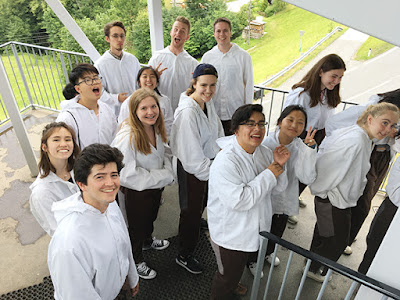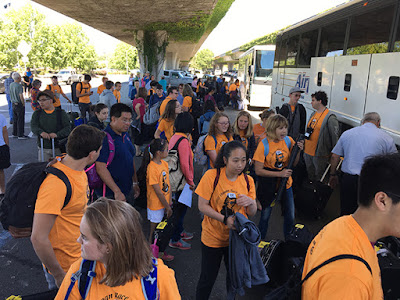 |
Young musicians prepare to enter the salt mine at Hallein
Photo: Colin Talcroft |
For many hundreds of years salt has been mined near Salzburg. The SRSYO musicians today visited the salt mine in the Dürnnberg at Hallein, about 30 minutes south of Salzburg, where Celtic settlers in the area began mining with wood and iron hand tools as early as 200BC. After a long lapse, mining began again in the medieval period and continued into the 20th century. Tourism has long been part of activity at the mine (the Hallein mine bills itself as the oldest exhibition mine in the world; visitors have been allowed to tour the shafts since the 16th century).
 |
Wooden slides used to enter the
lower levels of the salt mine
Photo: Colin Talcroft |
Modern mining used modern methods. The salt deposits at Hallein are not crystalline. The salt is in seams about 40% salt mixed with clay, limestone, and other substances. The salt was extracted using water even in Celtic times (to create brine that was then heated to cause evaporation and crystallization), but industrial-scale slurry mining eventually became the norm with water pumped directly into shallow mine excavations and brine pumped out after insoluble components settled out of the mix.
Visitors enter the mine as modern miners did, wearing white, hooded uniforms (provided by the mine for the tour—ill-fitting and probably unnecessary but part of the fun—see photo above) and on a small-gauge railway with no cars, straddling a metal beam, everyone pushed close together in seated single file (there are no real seats), and then move further underground on a series of wooden slides, polished from long use. Both the fast-moving train and the slides were a hit, with shouts of "Wheee!!!" echoing through the mine shafts as we raced through the dimly lit tunnels on the train, each holding on to the closest passenger in front of us, or on the slides. Once underground at mining levels, a very slow boat takes visitors across one of several underground lakes, remnants of the slurry-based mining process (the 100-yard trip was a bit comically dramatized with colored lights and incongruous music). Walking about a mile through the tunnels to the exit point takes visitors across the Austrian–German border underground and back again, no passport required.
 |
Nathan Garcia-Diaz fills a water
bottle at a street fountain in Salzburg
Photo: Colin Talcroft |
It was then early back to the hotel for dinner and rest before the second day in Salzburg, which will include the group's first concert performance. About the salt mine, Thomas Gosnell said "I had no idea how diverse the uses of salt were. It's not just for food. The slides were a good touch, but I guess that's how miners actually got to work. It would have taken far too long otherwise. It was fun." Sophia Petrascu (bass) commented "It was cool—both in temperature and awesomeness!" And cool was important, the weather has been hot and humid. Everyone has appreciated the delicious
alpenwasser (water from the Alps) available everywhere, even from street fountains in old Salzburg.
 |
Molly Zhou (Oboe) fills a water bottle in Salzburg
Photo: Colin Talcroft |






Comments
Post a Comment